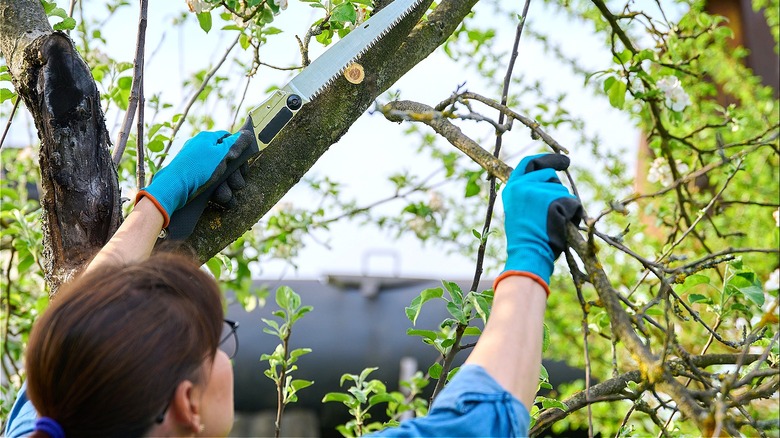The Gardening Myth With Trees You Need To Stop Believing
Anyone with a penchant for gardening is familiar with the laurels of pruning trees. It helps to evict dead and broken branches, remove low and crossing branches causing a tripping hazard, and, like a savvy tailor, control the tree size with perfect precision. However, the next step of applying pruning paint to tree wounds — claimed to fortify it against disease and rot — is a prevailing gardening myth that warrants a closer look.
Just as new tissue forms over the scab on a scraped knee, performing its recuperative miracle, trees, too, have a similar adeptness. More human-like than we credit them for, the green companions have their way of recovering from pruning traumas. And, because of this, dressing tree wounds is often less of a help and more of a hindrance, interfering with the normal process of wound tissue development.
It is a little like offering someone too much help with a task they can complete independently. Nevertheless, every rule has its exceptions. In a handful of situations, painting over a tree wound can prove beneficial. But it's like landing a dart perfectly on a board; the technique is crucial.
Why you shouldn't paint tree wounds after pruning
Your tree knows no Picasso, and the aesthetic halo of a fresh coat of paint after trimming its branches hardly changes anything for its well-being. Smearing paint on tree wounds has proven a gardening myth. Pruning paint was once thought to stave off decay, expedite healing, and, less vainly, improve the wound's appearance — claims that have been largely debunked. Still, the internet seems to be a relentless purveyor of largely petroleum-based products, professing to be multipurpose yet possibly harmful to the living tissues of trees.
A wound dressing like tar or paint is less of a band-aid and more of a roadblock, hindering the closing of tree wounds and sparking off a domino effect of undesired consequences. It asphyxiates the tree injury spot, cutting off oxygen necessary for oxidative processes, hence hampering callus formation and compartmentalization. As for compartmentalization, it's an elegant self-protective progression where new wood proliferates around the wound, creating a sturdy barrier that forestalls infections or decay.
It also turns out that painting over a tree's wound could even set up a feast for pathogens, rolling out a red carpet for spreading disease. And when the paint coating cracks? The tree wound hits a moisture jackpot, and the paint you consider a botanical band-aid becomes merely a padded cell for decay initiation. But should your tree pruning escapades involve species susceptible to pathogens that hitch rides on insects attracted to fresh wounds (cue birch and oak), a dab of pruning paint may be just the defensive strategy you need.
What to do about tree pruning wounds
Squash that gardening myth that trees are helpless in the face of injury; after all, they've survived for millennia by being experts at self-healing. Like a calculated mischievous move by your cat right after you've finished airing the hallway, trees waste no time springing into action after a pruning injury. Their inbuilt fencing system cordons off the wounded area, putting it in a state of quarantine — a concept a little too close to home lately. The best course of action is forgoing the old practice of dressing the wounds following pruning trees and letting Mother Nature unfurl her magic. For pine trees, smearing the resin that naturally forms post-pruning all over the wound helps to encourage sealing and prevent the site from turning into a decay haven.
However, for highly nutrient-starved soil, applying mineral fertilizers might be necessary to promote callus development. Treat the dosage with precision, though, as too much fertilizer can cause root burn, gross overgrowth, and increase susceptibility to unwelcome pests and pathogens, unsettling your tree's equilibrium. Pruning should be done meticulously at the branch collar, with caution not to disrupt the trunk wood. This demands sharp, clean cuts rather than roughly hacked ones. As an added bonus, reserve tree pruning for winter when trees are dormant. It is also when infection rates and temperatures mimic your motivation to brave the cold outside — both are at their lowest.


